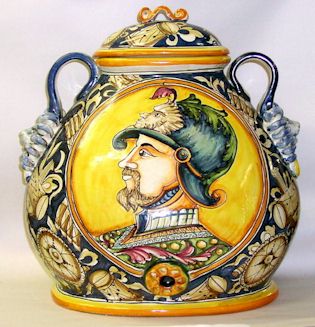|
Deruta offers a number of interesting sights for
visitors, in addition to its ceramics outlets. The town is situated 15 km south of Perugia on a hill that overlooks the
valley of the
Tiber (Valtiberina) in Umbria. The new town extends along the Via Tiberina, parallel to the
road that goes towards Rome.
Opposite the town hall rises the Romanesque-Gothic Church of S. Francesco with the adjacent convent where Pope Urban IV died on October 2, 1264. The
14 C bell-tower has ogival mullioned windows. The interior, made up of one nave with polygonal apse, contains numerous
14 C frescoes of the Siennese school. On the left side of the altar there is a martyrdom of St. Catherine of Alexandria (1339),
protector of Deruta's ceramicists, whose saint's day is 25 November, and another fresco with the Madonna, Child and Saints by Domenico Alfani. Ceramic art from DerutaCeramics remain one of the most important reasons for visiting Deruta. This Umbrian town is world-famous for its ceramic art, which dates back to the Middle Ages. The oldest and most important commissioned works date back to the 13 C, but the highest level of development was achieved by the masters of Deruta beginning in the early 16 C. Thanks to the ever-growing fame of Deruta's ceramicists, their workshops were entrusted with the execution of the pavements of the Chapel of the Palazzo dei Priori and of the Sacristy of the Basilica of S. Pietro in Perugia, and of the Baglioni Chapel in Spello. In the civic museum of Deruta there are remnants of the flooring of the Church of S. Francesco (1523-24).
Among the best known ceramic masters from Deruta are: Giacomo Mancini, known as "El
Frate" (1545), Andrea di Cecco (1584), Lazzaro di Battista Faentino, Francesco Urbini, Gregorio Caselli (1770) and a certain "Paolo da Deruta" who in 1516 worked under the great
ceramicist Mastro Giorgio Andreoli from Gubbio. |

